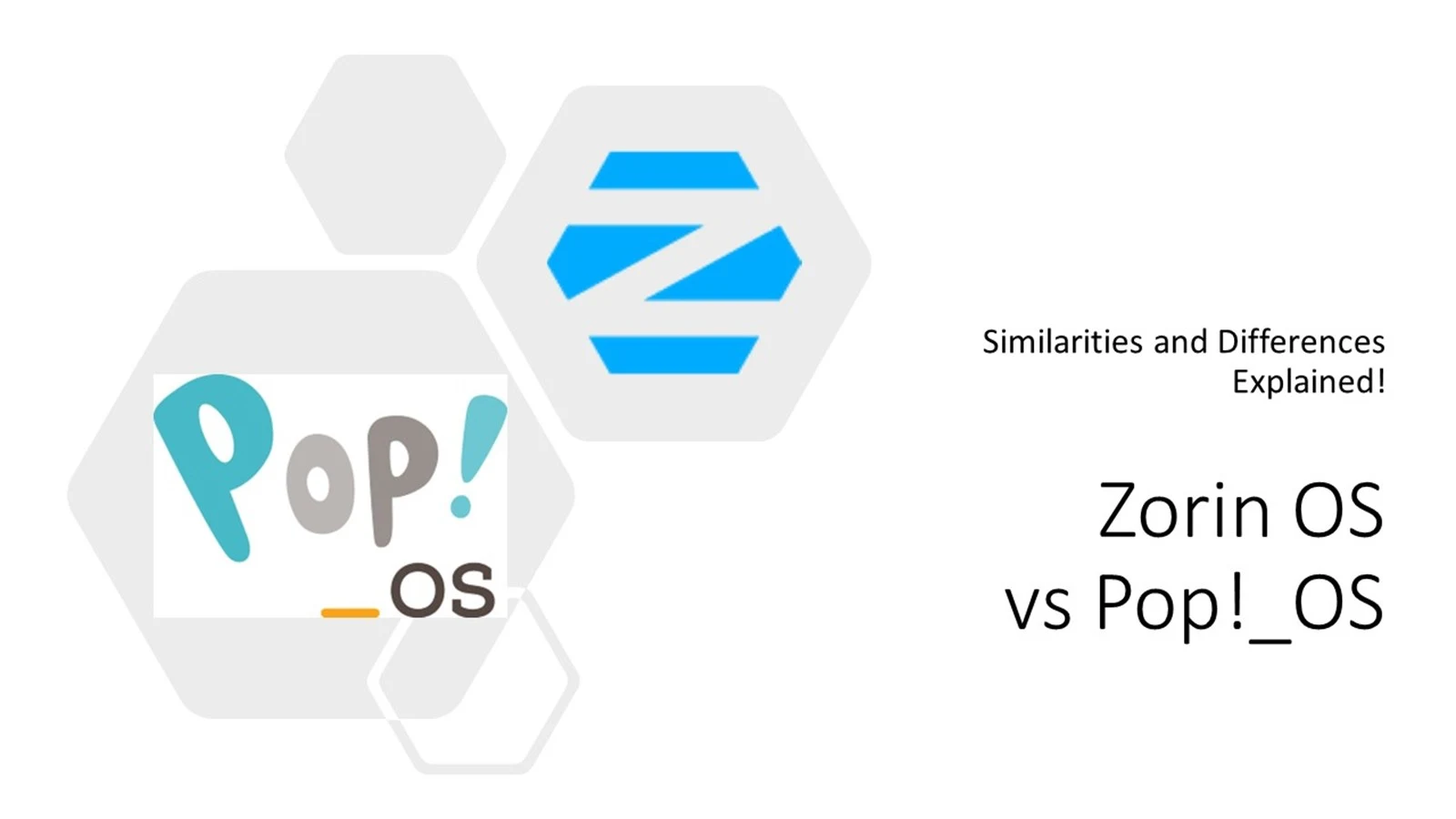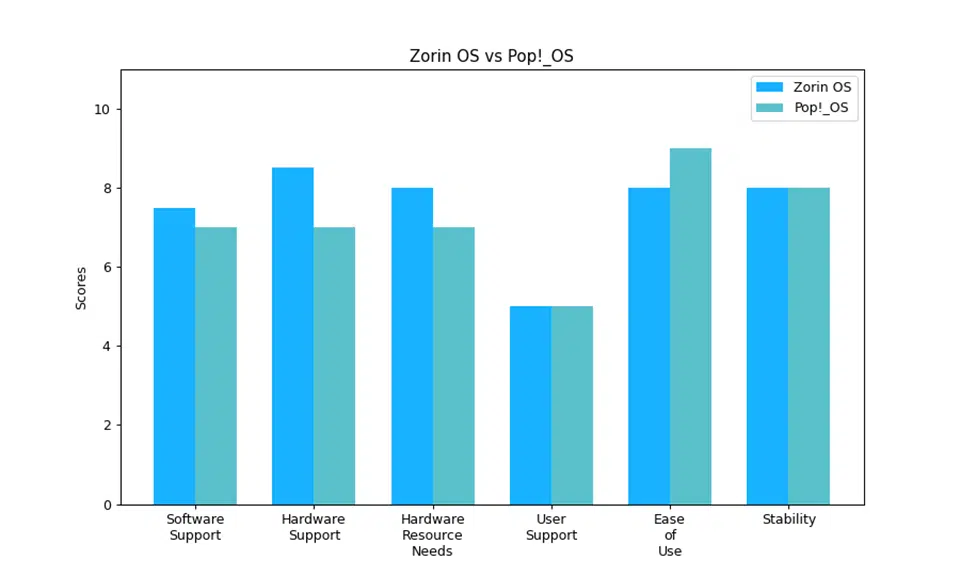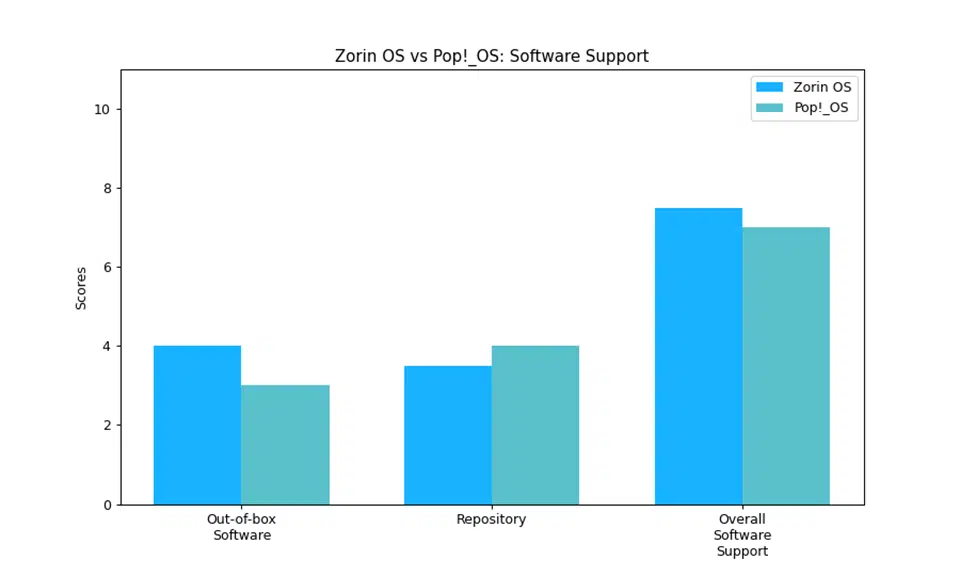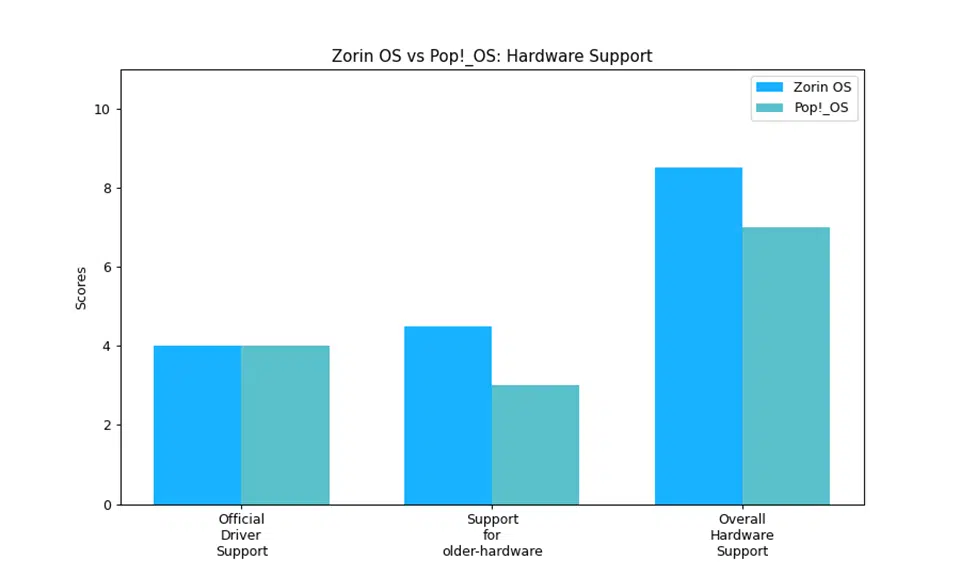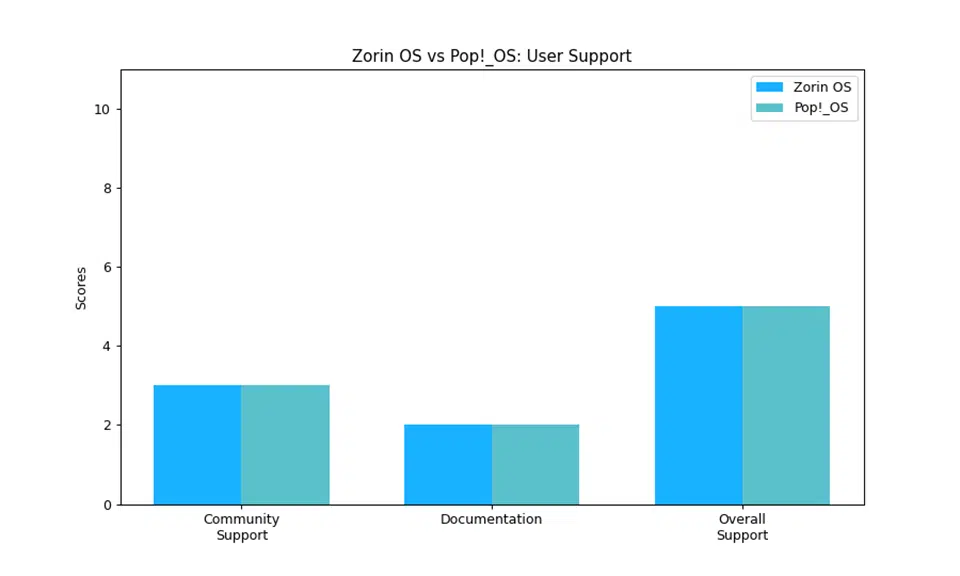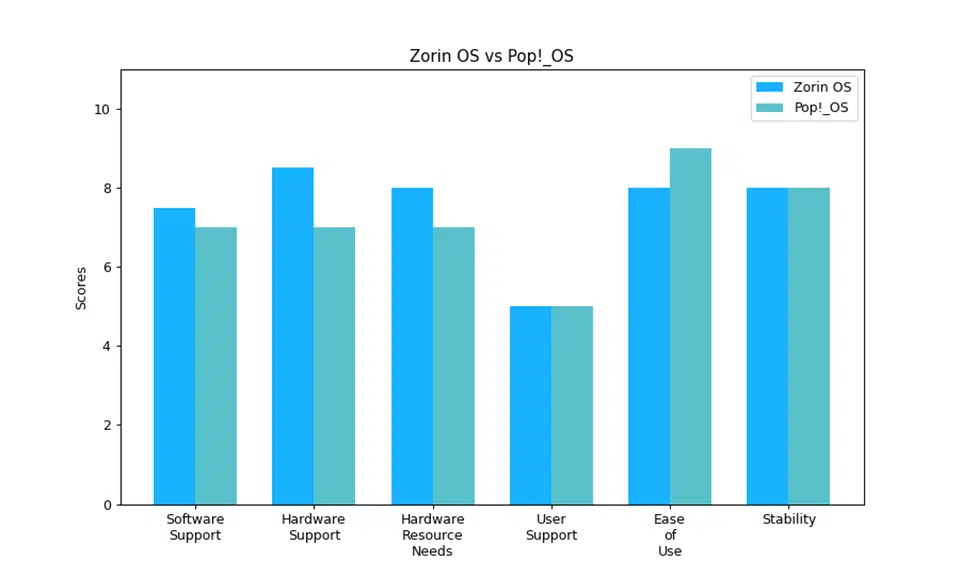Credits:
In this article let us have a look at 2 very popular distros Zorin OS and Pop!_OS and see where each distro shines so that you can pick one that best suit your needs!
For those of you in a hurry, here is the short version of the answer.
The Short Version Of The Answer
What are the differences between Zorin OS and Pop!_OS? The main difference between Zorin OS and Pop!_OS is Zorin OS is meant for users who need best WINE support for using windows apps while Pop!_OS is meant for users who need a Ubuntu-based gaming distro
The table below highlights the important differences between the 2 distros
| Zorin OS | Pop!_OS | |
| Organization Name | Zorin OS is a distro focused on regular users (as opposed to engineers) built with the aim of providing a beginner-friendly opensource distro.
Organization Type: Community |
Pop!_OS is a distro being developed by a company named system76.
Organization Type: Company |
| Expertise Level Needed | Beginner | Beginner |
| Based On | Ubuntu | Ubuntu LTS Release |
| Target Use-cases | General-purpose Distro.
Best Use-case: Good first distro for switching from Windows or Mac Other use cases: Gaming, Content consumption, workstation |
General-purpose Distro.
Best Use-case: Gaming on Linux Other Use-cases: General use as a laptop distro |
| Software Support | 7.5/10 Out of the box software: 4/5 Software Repository: 3.5/5 |
7/10 Out of the box software: 3/5 Software Repository: 4/5 |
| Hardware Support | 8.5/10 Official driver support: 4/5 Support for older hardware: 4.5/5 |
7/10 Official driver support: 4/5 Support for older hardware: 3/5 |
| Hardware Resource Needs | middleweight | Middleweight |
| Support | 5/10 Paid support: not available Community: Documentation: 2/5 |
5/10 Paid support: Available (free for system76 hardware owners) Community: 3/5 Documentation: 2/5 |
| Ease of use | 8/10 Easy | 9/10 Beginner level |
| Stability | 8/10: stable
Based on Ubuntu LTS hence Zorin OS is stable |
8/10: Very stable
Based on Ubuntu LTS release and hence Pop OS is a very stable distro! |
| Release Cycles | Fixed Release
Release schedule: There is no strict schedule, the features and bug fixes are rolled out once they are ready. |
Fixed Release
Every 2 years after the release of Ubuntu LTS |
The graph below summarizes the table and compares the 2 distros and shows us how they compare with each other on various factors (Higher the points the better that particular feature is in a given distro)
That is just the short version of the answer, let’s go ahead and look at the longer and more informative version and learn more about the similarities and differences between 2 distros.
The Linux Distributions World
The word Distro is short for “Distribution”. Since the Linux source code is open for everyone to see, large communities started evolving to bring together Operating Systems suited towards specific needs/goals.
These “specific needs/goals” include, but not limited to the following.
- producing documents
- writing programs and creating software
- editing pictures, videos, audio and multimedia-production related works
- store sensitive information by securing the operating system so that no one can hack into it or
- just browse the internet and consume media.
Say a community of people just wanted to browse the internet with their computers, then there is no point giving them the software to write programs in. Thus since every community’s needs and goals were different these communities started distributing built images of this operating system with all the essential tools installed. These prebuilt images are called distros!
If you wish to know more about the reason behind the presence of so many choices in the Linux World, I suggest reading the article given below.
Reasons Behind The Existence of SO MANY Linux Distros: An Analysis!
The Main Factors of Comparison
The factors mentioned above are just a small list of 100s of factors that differentiate distros. If you are either switching from some other OS to Linux or you are in the process of choosing your next Linux distro and you are confused which one to choose, you need to have a look at these top 5 decision-making factors
- Factor#1: Good Match with your Particular use-case
- Factor#2: Support for your favourite software
- Factor#3: Hardware Support and Proprietary Driver Support
- Factor#4: Your level of expertise in Linux
- Factor#5: Hardware Resource Needs
I have written a separate article explaining these factors which you can find in the link below
Top 5 Factors To Choose Between Linux Distros!
Let’s have a look at each of these important factors and see how Zorin OS and Pop!_OS compare against each other.
Factor#1: Good Match with your Particular use-case
By use-case, I mean the type of work you are going to be doing on your computer. Linux distro world originated because of the difference in use cases.
Zorin OS’s goal is wildly different from that of Pop!_OS’s.
Let’s have a brief comparison between Zorin OS and Pop!_OS in terms of goals, target users and best use cases to employ these distros.
| Zorin OS | Pop!_OS | |
| Goal | To provide a beginner-friendly opensource distro. | To be an elegant alternative to Ubuntu, with a focus on ease of use and performance |
| Target users | Windows users who want to try out Linux and Linux users who want a distro for gaming. | General users who need a good-looking distro with good support for gaming |
| Best Use-Cases to Employ the Distro | Best Use-case: Good first distro for switching from Windows or Mac
Other use cases: Gaming, Content consumption, workstation |
Best Use-case: Gaming on Linux
Other Use-cases: General use as a laptop distro |
Factor#2: Support for your favourite software
If your main work involves some specific software or latest versions of a given software then that becomes a decision-making factor for choosing a Linux Distribution. So before fixing on a given distro, be sure to google if that distro has official support for your main software needs.
The factors you need to be considering include the following
- Out of the Box support: The software that the distro ships with.
- Repository Support: The curated software that is available on the official repos
- Type of release cycle: This decides the trade-off between up-to-date software and stable tested software.
- Availability of Graphical Software managers
- Package manager used: This can decide the ease of which you can install and uninstall software
Let’s see how Zorin OS and Pop!_OS fair up against each other in the category of Software support
| Zorin OS | Pop!_OS | |
| Out of the Box Software | 4/5: The core edition comes with all the necessary software to start using the operating system straight away after installation and the ultimate edition (paid version) comes with a lot of apps preinstalled. | 3/5: Comes with just the basics |
| Repository Support | 3.5/5: The official repository is growing, and since this OS is based on Ubuntu, you can use the synaptic package manager to install system packages |
4/5: Enjoys Ubuntu’s big collection of packages |
| Type of release cycle | Fixed Release
Release schedule: There is no strict schedule, the features and bug fixes are rolled out once they are ready. |
Fixed Release
Every 2 years after the release of Ubuntu LTS |
| GUI Software Management Tools | Available Software centre and Synaptic package manager |
Available
Pop Shop |
| Package manager used | Supports apt, snappy and flatpak | APT and snappy |
The bar chart below summarizes the table above. As you can see, Zorin OS is better than Pop!_OS in terms of Out of the box software support. Pop!_OS is better than Zorin OS in terms of Repository support.
Hence, Zorin OS wins the round of Software support!
Refer to the article below if you wish to learn more about package managers.
A Beginners Introduction To Linux Package managers: apt, yum, dpkg & rpm
Factor#3: Hardware Support and Proprietary Driver Support
Not all Linux distros support proprietary drivers officially. Depending on your computer’s hardware, you may or may not have open-source driver support from the manufacturers. This is especially true for hardware such as graphics cards and network cards. Hence it is a good idea to take “driver support” into consideration while choosing your next distro.
The factors you need to be considering include the following
- Distro’s Policy of use of opensource vs proprietary 3rd party software
- Official driver support by Major Companies
- 3rd party driver support from official repos
- Support for older hardware
The table below shows how these 2 distros compare in terms of Hardware support.
| Zorin OS | Pop!_OS | |
| Distro’s Policy | Proprietary drivers officially supported | Proprietary drivers officially supported |
| Official driver support by Major Companies | 4/5, since based on Ubuntu LTS, the drivers provided by major companies like NVidia are made available for Zorin users. | 4/5, since based on Ubuntu LTS, the drivers provided by major companies like NVidia are made available for PopOS users. |
| 3rd party driver support | 3rd party repos available | 3rd party repos available |
| Support for older hardware | 4.5/5: still supports old 32-bit systems | 3/5: Ubuntu has dropped support for 32bit processors, hence KDE neon will not work on older machines |
The bar chart below summarizes the table above. As you can see, both Pop!_OS and Zorin OS got the same points when it comes to official driver support. Zorin OS is better than Pop!_OS in terms of support for Older Hardware.
Hence, Zorin OS wins the round of Hardware support!
Refer to the article below if you wish to have a look at some of the top distros in terms of hardware support.
Best Distro For Software And Hardware Support: A Comparison!!
Factor#4: Your level of expertise in Linux
Depending on your level of expertise in Linux, the choice of the distro you need will vary. This is because of the following factors
- Ease of use: beginner, intermediate, expert
- Paid customer support: available, not available
- Online community support: great, good, okay, not good, no support
- Available Documentation: Great documentation, Good documentation, Okay documentation, no documentation
Let’s see the level of support available for Zorin OS and Pop!_OS and see how they compare against each other
| Zorin OS | Pop!_OS | |
| Ease of Use | beginner | beginner |
| Paid Customer Support | The buyers of Ultimate edition can enjoy faster responses for support queries and they sell laptops preloaded with Zorin OS, but there is no paid support. | Available: Pop OS sells hardware with their distro preinstalled and offers lifetime support for users! |
| Online Community Support | 3/5 good: small yet responsive community | 3/5: PopOS has a growing online community |
| Documentation | 2/5 Okay documentation, focused on beginners’ tutorials | 2/5: Okay documentation, focused on beginners’ tutorials |
The bar chart below summarizes the table above. As you can see, both Pop!_OS and Zorin OS got the same points in terms of online community support. Both Pop!_OS and Zorin OS got the same points in terms of Documentation.
Hence, this round is a tie between Pop!_OS and Zorin OS!!
Factor#5: Hardware Resource Needs
This is an important factor if you are planning to employ Linux on a computer with limited hardware resources. This may be an old machine or a new one with less than stellar specs.
The factors you need to be considering include the following
- Category: Lightweight or Middleweight or Heavyweight
- RAM Requirements to have a snappy system &
- Minimum processor requirements
Let’s see how Zorin OS and Pop!_OS fair up against each other in terms of Hardware resource needs
| Zorin OS | Pop!_OS | |
| Category | Middleweight | Middleweight |
| Minimum RAM requirements | (Minimum) 512MB for the Lite edition | 2GB
4GB Recommended |
| Minimum Processor Requirements | (Minimum) 700MHz single-core 32-bit for the Lite edition | dual-core 64bit recommended (no minimum requirements given out officially) |
Refer to the article below if you wish to have a look at a step by step guide for choosing a Linux distro for your computer’s specifications.
A Complete Guide For Choosing A Distro For Your Computer’s Specs..!!
The Results!
Let us know go ahead and see the results of our comparison! Have a look at the Bar chart below.
As you can see Zorin OS wins in Software support, Hardware support, and Hardware Resource needs.
Pop!_OS wins in Ease of use.
There is a tie between the 2 distros in User support, and Stability.
I suggest you pick the distro that best suits you based on this graph. For example, if hardware support is more important to you, then pick the distro that has better support for your hardware!
Summary
To summarise the article here is the comparison table from the beginning of the blog again.
| Zorin OS | Pop!_OS | |
| Organization Name | Zorin OS is a distro focused on regular users (as opposed to engineers) built with the aim of providing a beginner-friendly opensource distro.
Organization Type: Community |
Pop!_OS is a distro being developed by a company named system76.
Organization Type: Company |
| Expertise Level Needed | Beginner | Beginner |
| Based On | Ubuntu | Ubuntu LTS Release |
| Target Use-cases | General-purpose Distro.
Best Use-case: Good first distro for switching from Windows or Mac Other use cases: Gaming, Content consumption, workstation |
General-purpose Distro.
Best Use-case: Gaming on Linux Other Use-cases: General use as a laptop distro |
| Software Support | 7.5/10 Out of the box software: 4/5 Software Repository: 3.5/5 |
7/10 Out of the box software: 3/5 Software Repository: 4/5 |
| Hardware Support | 8.5/10 Official driver support: 4/5 Support for older hardware: 4.5/5 |
7/10 Official driver support: 4/5 Support for older hardware: 3/5 |
| Hardware Resource Needs | middleweight | Middleweight |
| Support | 5/10 Paid support: not available Community: Documentation: 2/5 |
5/10 Paid support: Available (free for system76 hardware owners) Community: 3/5 Documentation: 2/5 |
| Ease of use | 8/10 Easy | 9/10 Beginner level |
| Stability | 8/10: stable
Based on Ubuntu LTS hence Zorin OS is stable |
8/10: Very stable
Based on Ubuntu LTS release and hence Pop OS is a very stable distro! |
| Release Cycles | Fixed Release
Release schedule: There is no strict schedule, the features and bug fixes are rolled out once they are ready. |
Fixed Release
Every 2 years after the release of Ubuntu LTS |
Hope you have got enough data to choose between these 2 amazing distros!
And with that, I will conclude this article!
I hope you guys enjoyed this article and learned something useful.
If you liked the post, feel free to share this post with your friends and colleagues!
Related Articles
Here are some of my other articles that might interest you!
What Is The Best Linux Distro? Analysis & Comparison..!!
A Step By Step Plan To Learn Linux..!
Best Linux Distro For Workstation: Analysis and Comparison!!
A Complete Guide For Choosing A Distro For Your Computer’s Specs..!!
Best Distro For Software And Hardware Support: An Analysis.!!
Distro-Hopping, What, Why & How Explained!
Reasons Behind The Existence of SO MANY Linux Distros: An Analysis!

